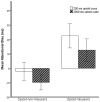Opioid attentional bias and cue-elicited craving predict future risk of prescription opioid misuse among chronic pain patients
- PMID: 25282309
- PMCID: PMC4252536
- DOI: 10.1016/j.drugalcdep.2014.09.014
Opioid attentional bias and cue-elicited craving predict future risk of prescription opioid misuse among chronic pain patients
Abstract
Background: Some chronic pain patients receiving long-term opioid analgesic pharmacotherapy are at risk for misusing opioids. Like other addictive behaviors, risk of opioid misuse may be signaled by an attentional bias (AB) towards drug-related cues. The purpose of this study was to examine opioid AB as a potential predictor of opioid misuse among chronic pain patients following behavioral treatment.
Methods: Chronic pain patients taking long-term opioid analgesics (n=47) completed a dot probe task designed to assess opioid AB, as well as self-report measures of opioid misuse and pain severity, and then participated in behavioral treatment. Regression analyses examined opioid AB and cue-elicited craving as predictors of opioid misuse at 3-month posttreatment follow-up.
Results: Patients who scored high on a measure of opioid misuse risk following treatment exhibited significantly greater opioid AB scores than patients at low risk for opioid misuse. Opioid AB for 200 ms cues and cue-elicited craving significantly predicted opioid misuse risk 20 weeks later, even after controlling for pre-treatment opioid dependence diagnosis, opioid misuse, and pain severity (Model R(2)=.50).
Conclusion: Biased initial attentional orienting to prescription opioid cues and cue-elicited craving may reliably signal future opioid misuse risk following treatment. These measures may therefore provide potential prognostic indicators of treatment outcome.
Keywords: Attentional bias; Chronic pain; Cue-reactivity; Dot probe; Implicit cognition; Opioid misuse.
Copyright © 2014 Elsevier Ireland Ltd. All rights reserved.
Conflict of interest statement
Figures

References
-
- Becker S, Gandhi W, Schweinhardt P. Cerebral interactions of pain and reward and their relevance for chronic pain. Neurosci Lett. 2012;520:182–187. - PubMed
-
- Besson JM. The neurobiology of pain. Lancet. 1999;353:1610–1615. - PubMed
-
- Cleeland CS. Brief Pain Inventory–Short Form (BPI–SF) MD Anderson Cancer Center; Houston, TX: 1994.
Publication types
MeSH terms
Substances
Grants and funding
LinkOut - more resources
Full Text Sources
Other Literature Sources
Medical

